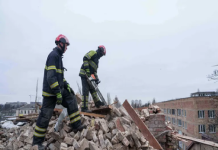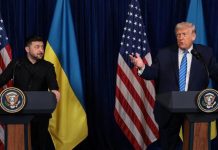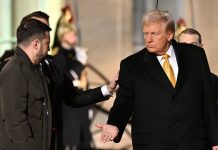Vilnius, Lithuania (AP)- The escalating conflict between Russia and Ukraine takes center stage as President Joe Biden and his NATO counterparts gather for a two-day summit in the Lithuanian capital, commencing on Tuesday. The leaders’ discussions will primarily focus on supporting Ukraine during the ongoing war, enhancing its relationship with NATO without formal membership, and establishing security guarantees to prevent future Russian invasions.
The summit attendees in Vilnius are expected to endorse new defense plans designed to counter any potential expansion of the conflict by Russian President Vladimir Putin beyond Ukraine and into allied territories. Additionally, they will explore strategies to address defense spending concerns arising from the provision of aid to Ukraine, which has strained national military budgets.
The central focus of the NATO summit revolves around Ukraine and the actions required to support the country. In 2008, former U.S. President George W. Bush pledged that Ukraine would eventually become a NATO member. Presently, Ukraine faces the urgent task of defending itself against a full-scale invasion by Russia, an adversary NATO has confronted in the past. The international community recognizes Ukraine’s pursuit of its interests, prompting countries to provide significant aid, economic support, and military assistance.
While NATO is not yet prepared to initiate membership discussions with Ukraine, it is actively engaged in training and modernizing Ukraine’s armed forces and security institutions. These efforts aim to enable the country to join NATO’s ranks once the conflict concludes. The summit will establish a new forum, the NATO-Ukraine Council, for consultations between the two parties.
Although primarily an issue for individual allies, discussions on protecting Ukraine from future invasions are set to dominate the Vilnius summit. While NATO membership provides robust collective defense through the principle of “all for one, one for all,” granting Ukraine membership requires unanimous agreement among the 31 member states, which remains elusive. As an alternative, major allies such as the United States, United Kingdom, France, and Germany could pledge to shield Ukraine from further attacks. NATO and the European Union would support this military protection by providing additional financial assistance and aid. While conclusive decisions are unlikely during the summit, leaders will utilize this important occasion to outline the nature of these guarantees.
NATO Secretary-General Jens Stoltenberg, Sweden, and nearly all allies concur that the country has fulfilled the necessary criteria to join the military alliance. However, Turkish President Recep Tayyip Erdogan disagrees and intends to draw attention to this matter at the summit. Sweden, having abandoned its long-standing military neutrality, seeks protection under NATO’s security umbrella. The country has made legislative changes, including lifting an arms embargo on Turkey, to address Erdogan’s concerns, but these efforts have proven futile thus far. Erdogan has utilized this issue during recent election campaigning, seeking upgraded F-16 fighter jets from the United States and potentially using Sweden’s membership as leverage.
A perennial issue, defense spending will feature prominently at the summit. The United States frequently criticizes its allies for failing to meet the recommended defense budget targets. With substantial resources allocated to Ukraine, the necessity of increasing national military budgets becomes evident. In 2014, NATO allies agreed to work toward spending at least 2% of their gross domestic product (GDP) on defense within a decade, with the 2024 deadline fast approaching. At the Vilnius summit, leaders are expected to endorse raising the defense spending floor to 2%, signifying the minimum requirement rather than the maximum.
NATO is currently undergoing a major overhaul of its defense plans, the most significant since the Cold War, in anticipation of potential territorial expansions by Putin’s Russia. Presently, around 40,000 troops stand ready from Estonia to Romania, with daily flights of approximately 100 aircraft and 27 warships patrolling the Baltic and Mediterranean Seas. Under the new defense plans, NATO aims to deploy up to 300,000 troops to its eastern flank within 30 days. The plans divide NATO’s territory into three zones: the high north and Atlantic area, a zone north of the Alps, and another in southern Europe. These classified documents outline which countries and equipment should defend each threatened area.
Although not officially on the agenda, NATO hopes that Belarus, Lithuania’s neighboring country and Russia’s primary supporter, does not play an unexpected role in the summit or the Ukrainian conflict. Given its close proximity to Vilnius, concerns arise regarding the possibility of Wagner mercenary leader Yevgeny Prigozhin seeking refuge in Belarus and the potential recruitment of his fighters. While preparations for hosting large groups of soldiers have been observed in Belarus, they have not yet been deployed to the country. Belarusian President Alexander Lukashenko recently claimed to possess Russian tactical nuclear weapons, threatening their use to protect his nation. NATO officials believe this to be a bluff, but given Putin’s history of nuclear saber-rattling, concerns persist as leaders gather in Vilnius.
The NATO summit in Vilnius serves as a critical forum for addressing the Ukraine crisis, bolstering defense capabilities, and fostering international cooperation among member states. Leaders aim to demonstrate solidarity with Ukraine, fortify regional security, and chart a path forward to protect the interests of NATO’s allies.






